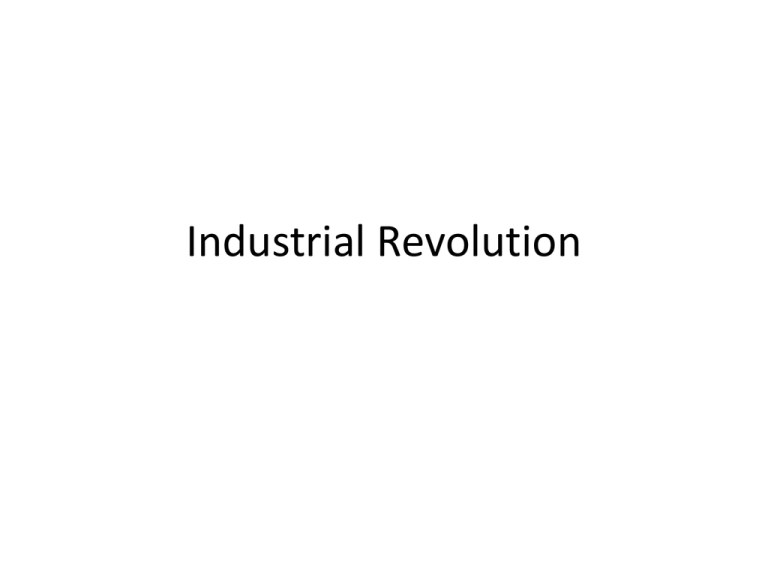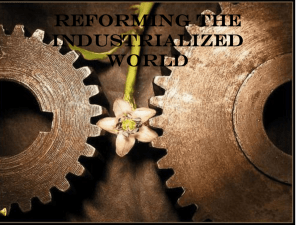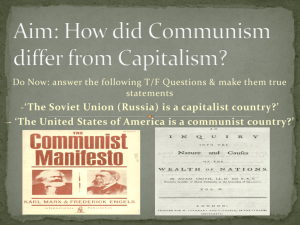Industrial Revolution review
advertisement

Industrial Revolution In the ________ __________, millions of families went to the cities where they had to work to make enough money to support the family, but unlike life on the farms, the parents often worked in different factories. Children often worked in factories as well, separating the family. Industrial Revolution The _______ ___________ was used for more than just transportation. It was also the catalyst of the factory system, generating enough power to run huge machines that humans operated in assembly line fashion. Steam engine Under this policy, nations acquired incredible wealth by colonizing regions with natural resources, then taking those resources without compensating the natives and sending the resources back to Europe, where they were made into finished products. mercantilism In 1776, this person wrote in the Wealth of Nations that economic prosperity and fairness is achieved through private ownership. Individuals should own the means of production and sell their products and services for a fee on the open market, where the demand for their goods and services would their prices and availability. Adam Smith This person did not believe that the factory workers had genuine opportunities. He believed that they were being exploited and that this exploitation was an inevitable consequence of the capitalist industrialization. Karl Marx Karl Marx wrote that the working class would eventually revolt and take control of the means of production. What was its name of this work? The Communist Manifesto What country would have the first successful Communist Revolution in 1917? Russia #3 In 1701, something called the seed drill was invented by a scientific farmer named __________. His machine pushed seeds deep into the soil in well spaced rows. a) b) c) d) Elijah McCoy Eli Whitney Jetrho Tull John Kay #5 The Industrial Revolution began in a) Great Britain b) United States c) France d) Germany #6 In 1764, the _________was invented by James Hargreaves, it could spin 8 or more spools of yarn at a time. a) b) c) d) Power loom Spinning Jenny Bessemer Process Cotton Gin #7 Then in 1785, the __________ was invented. It used water power to weave cloth, and it did this fast. With this invention, more cotton was needed. a) b) c) d) Power loom Spinning Jenny Bessemer Process Cotton Gin #8 In 1793,______________, an American, invented the cotton gin. This invention pulled the seeds out quick, and could do the work of fifty people. a) b) c) d) Elijah McCoy Eli Whitney Jetrho Tull John Kay #9 In 1769, James Watt figured out how to build a ___________________. It needed coal to run, and could work anywhere. So pretty soon the factories could be located anywhere. a) Internal combustible engine b) Refrigerator c) Electric generator d) Steam engine #10 Patented in 1855, this was the first inexpensive industrial process for the mass-production of steel from molten pig iron. a) Power loom b) Spinning Jenny c) Bessemer Process d) Steel Loom #11 Inventor of the 1831 mechanical reaper. It was a machine made for cutting wheat fast, rather than by hand like people had done for thousands of years. a) John Deere b) Christopher Sholes c) Cyrus McCormick d) Henry Bessemer #14 In the 1860’s __________________ he discovered that bacteria was what caused many diseases. He found out that heat could kill bacteria. His ideas helped make milk safer to drink. a) b) c) d) Louis Pasteur Pierre Curie Marie Curie Edward Jenner #15 He developed the smallpox vaccination a) b) c) d) Louis Pasteur Pierre Curie Marie Curie Edward Jenner #16 In this class were factory owners, business managers, merchants, investors, doctors, and lawyers. a) b) c) d) Lower Class Middle Class Upper Class None of the above #17 This capitalist philosopher believed that, if only government did not interfere, the free enterprise system could work automatically. He presented the classic expression of that view in his book, The Wealth of Nations, in 1776. a) b) c) d) Karl Marx Frederick Engels Adam Smith None of the above #18 An Economic theory that holds that government should play a very limited, hands off role in society. Because when all individuals are free to pursue their own private interests, an “invisible hand” works to promote the general welfare. a) b) c) d) Bolshevik Communism Constitutional Monarchy Laissez-faire capitalism None of the Above #20 The Communist Manifesto (1848) was written by _______________ and _________________. This writing first set out the basic concepts of communism, a collectivist ideology, which calls for the collective, or state, ownership of land and other productive property. a) Karl Marx and Adam Smith b) Karl Marx and Frederick Engels c) Adam Smith and Frederick Engels d) None of the above






